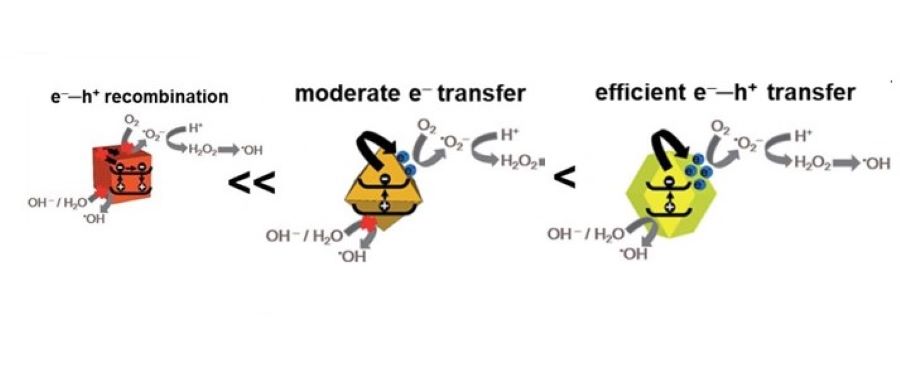PhD Top Stories
Matteo Bisetto
Facet engineering of cuprous oxide: a new frontier for photocatalysis
Doctoral Programme in Nanotechnology
In the last decades fossil fuels have been widely used for daily activities, contributing to a rapid increase of the Carbon Monoxide (CO2) concentration and the average temperatures. Scientific research focuses the attention on the development of new procedures to obtain “green” fuels and directly produce alcohols or hydrocarbons from recycled CO2. Due to the high stability of this molecule, an external energy is required to split CO2 and to obtain different products, among which the so-called Photocatalyst play a pivotal role. Generally, these photocatalysts are inorganic metal oxides, and, because of their particular structure, they allow capture of a broad part of visible light to re-use it in the catalytic process. Furthermore, metal oxides are highly abundant and they can be easily modified in order to increase their overall performances. Among different photocatalysts, cuprous oxide (Cu2O) is a promising material for a wide range of processes thanks to its good photocatalytic behaviour, its low cost and environmental impact and the possibility of tune its properties by changing the shape and size of the material. Crystal facet engineering allows to directly modify properties such as selectivity, absorption of radiation with different wavelength and reactivity toward a particular process. In this work, we aim to discuss the different synthetic procedures for the preparation of diverse Cu2O structures with a particular shape and the role of this material in the field of photocatalysis. In particular, with our method it is possible to synthesize Cu2O nanocrystals with systematic shape evolution, from the stable cubic to other more complex structures, by changing the amount of added hydroxylamine hydrochloride (NH2OH·HCl), the reducing agent used during this synthesis. The obtained Scanning Electron Microscopy (SEM) images confirm the direct relationship between the final shape of Cu2O nanoparticles and the added amount of NH2OH·HCl (Figure 1).

Figure 1: SEM images showing the shape evolution of Cu2O nanoparticles by increasing of NH2OH·HCl concentration during the synthesis.
Well-defined nanocrystals with different crystal facets show different atomic arrangements. For this reason, they exhibit unique properties and different reactivities (Figure 2).

Figure 2: This picture shows the different reactivity of three Cu2O shapes toward the photodegradation of an organic dye.
Thanks to this flexibility of the properties, Cu2O nanoparticles are widely used as photocatalyst, especially toward organic reactions, dye degradations, hydrogen production via water splitting and CO2 reduction. One of the biggest drawbacks of Cu2O is its poor stability during the time that implies a modification, mostly a worsening, of its behaviour towards the involved process. To overcome this issue, different hybrid Cu2O-based nanostructures were developed by coupling Cu2O with another catalyst. Such synergistic behaviour in the hybrid system not only enhances the photostability, but it may also increase the product selectivity and the overall performances. From this point of view, our efforts were focused on the development of composites based on the coupling of Cu2O with Graphitic Carbon Nitride (g-C3N4), an interesting 2D material with promising photocatalytic behaviour. To conclude, with this work we underlined the importance of shape control on the synthesis of Cu2O nanoparticles for photocatalytic applications. Different efforts still need to be done from the point of view of material optimization and comprehension of the mechanisms that rule catalytic processes. It is still very complicated evaluate and control CO2 photoreduction due to the variability of the shape, size and composition of the involved catalyst. However, with an optimization of the photocatalytic material it will be possible to have an appropriate reproducibility of the behavior and exploit these processes in the next future to drastically limit the human impact on the environment. We hope that the presented in-depth discussion will contribute to the discovery of new synthetic strategies to enable the preparation of diverse hybrid Cu2O. This may finally enable the design of low cost and more efficient Cu2O-nanostructures for solar to fuel conversion technologies.
Authors and affiliations
Sourav Rej1, Matteo Bisetto2, Alberto Naldoni1,3, Paolo Fornasiero2 Sourav Rej e Matteo Bisetto hanno contribuito equamente a questo lavoro.2Dipartimento di Scienze Chimiche e Farmaceutiche, ICCOM-CNR Trieste, INSTM-Trieste, Università di Trieste, Via L. Giorgieri 1, 34127 Trieste, Italia.
3Università di Scienze e Tecnologie elettroniche della Cina, Chengdu 610054, Cina.
Contact
Matteo Bisetto, email: matteo.bisetto@phd.units.itReference
Sourav Rej, Matteo Bisetto, Alberto Naldoni, Paolo FornasieroWell-defined Cu2O photocatalysts for solar fuels and chemicals.
Journal of Materials Chemistry A9, 5915-5951 (2021)
DOI: 10.1039/D0TA10181H
Informazioni aggiornate al: 31.8.2021 alle ore 12:02
Contact: Webmaster - Università di Trieste pagina curata da: Research Doctorate

Piazzale Europa, 1 - 34127 - Trieste, Italia -
Tel. +39 040 558 7111 - P.IVA 00211830328
C.F. 80013890324 - P.E.C. ateneo@pec.units.it



